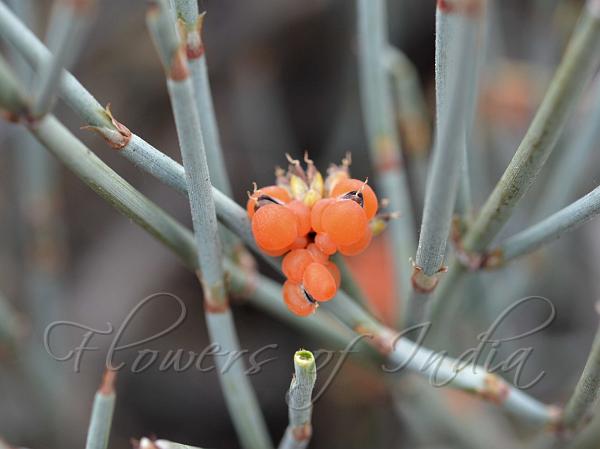|
| Central-Asian Jointfir |
|

|

| File size | 433839 |
| Original date | 8/22/14 2:31 PM |
| Resolution | 3008 x 2000 |
| Flash | Flash did not fire, auto |
| Focal length | 60.0mm |
| Exposure time | 1/400s |
| Aperture | 5.0 |
| Focus Distance | |
| Metering Mode | Multi-segment |
| Camera make | NIKON CORPORATION |
| Camera model | NIKON D3200 |
| Sensor type | OneChipColorArea |
|
|
|
|
Photo: |
Botanical name: Ephedra intermedia Family: Ephedraceae (Joint-Pine family)
Synonyms: Ephedra glauca, Ephedra tibetica, Ephedra persica, Ephedra microsperma
Synonyms: Ephedra glauca, Ephedra tibetica, Ephedra persica, Ephedra microsperma
Central-Asian Jointfir is an evergreen shrub up to 1 m
tall, densely branched, erect to spreading or sometimes with a creeping
stem producing single, erect, green primary branches. Branchlets are
yellowish or bluish green, often powdery, internodes usually 2-6 cm x
1.5-3.5 mm, straight or slightly bent. Leaves are arrange in whorls of
3 or opposite, fused for at least 2/3 their length, thus forming a
cone-like structure. Pollen cones are up to 8, whorled, usually
clustered at nodes, often stalkless; bracts in 3 or 4 pairs or whorls;
anthers 5-8, stalkless or shortly stipitate; staminate column slightly
protruding. Seed cones ellipsoid, ovoid, or oblong-ovoid; bracts in 2-5
pairs or whorls, outer ones fused at base, apical pair or whorl fused
for about 1/2 their length, margins membranous, spherical, red, and
fleshy at maturity; integument tube long, 3-5 mm, usually spirally
twisted. Berry is ovoid, red. Central-Asian Jointfir is native to
Afghanistan, Altay, Iran, Kazakhstan, Kirgizstan, Mongolia, Pakistan,
Tadzhikistan, Tibet, Transcaucasus, Turkmenistan, Uzbekistan, West
Himalaya, West Siberia. Flowering: May-June.
Medicinal uses: Central-Asian Jointfir has
several medicinal benefits, most notably helping with asthma. It
contains several different medicinally active alkaloids that are widely
used to treat that illness. This plant has similar effect to adrenaline
on the body, which makes valuable in treating asthma as it helps reduce
the swelling of lungs during attacks.
Central-Asian Jointfir has
several medicinal benefits, most notably helping with asthma. It
contains several different medicinally active alkaloids that are widely
used to treat that illness. This plant has similar effect to adrenaline
on the body, which makes valuable in treating asthma as it helps reduce
the swelling of lungs during attacks.
Medicinal uses:
 Central-Asian Jointfir has
several medicinal benefits, most notably helping with asthma. It
contains several different medicinally active alkaloids that are widely
used to treat that illness. This plant has similar effect to adrenaline
on the body, which makes valuable in treating asthma as it helps reduce
the swelling of lungs during attacks.
Central-Asian Jointfir has
several medicinal benefits, most notably helping with asthma. It
contains several different medicinally active alkaloids that are widely
used to treat that illness. This plant has similar effect to adrenaline
on the body, which makes valuable in treating asthma as it helps reduce
the swelling of lungs during attacks. | Identification credit: Saroj Kasaju | Photographed in Leh, Ladakh. |
• Is this flower misidentified? If yes,